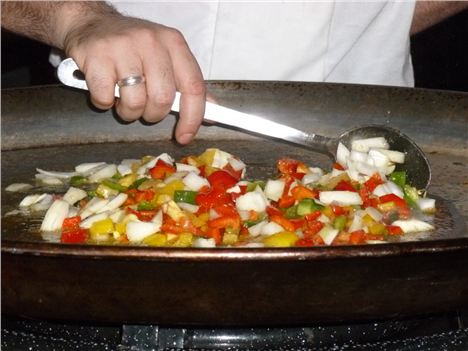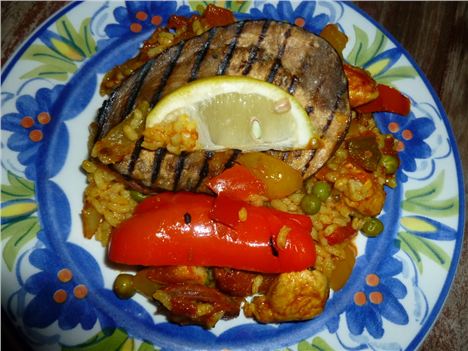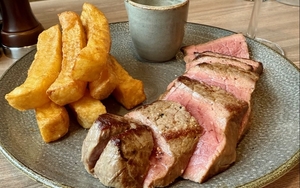LA TASCA has always been a good go-to option for the cash-strapped (Martin Lewis’ ‘Money Saving Expert’ website always seems to have a voucher) but it’s hardly been the top destination for top tapas.
The main event of the night was a paella cooking demonstration by the Executive Chef himself, and Malaga-born Kitchen Manager, Francis Sanchez.
Over the years, the chain has amassed a reputation as the purveyor of reheated plates of questionable quality – a nice enough place to go with friends on a cheap and cheerful night out, but not for good quality, authentic Spanish cuisine. McTapas, if you will.
Under new management, however, the chain is hoping to change this perception with a new menu that has been eighteen months in the making.
With new Executive Chef Antonio Bennetto at the helm, the focus now is on fresh ingredients and the best produce, sourced from regional Spanish suppliers, as this interactive map on their website demonstrates, click here.
But has this Spanish revival succeeded in wrenching the chain forwards into the 21st century? Or is it a case of too little too late? Confidential went along to their Paella Tasting event evening to find out.
The main event of the night was a paella cooking demonstration by the Executive Chef himself, and Malaga-born Kitchen Manager, Francis Sanchez.
But first, we had nibbles. A lovely Spanish waitress by the name of Sonso (short for Sonsoles) came round with a selection of small plates for us to try: Sausage sticks: salchichón and chorizo, Manchego cheese and sun-dried tomatoes, Tetilla cheese with red grape and quince.
The strong, robust flavours of the salchichón and chorizo were well-balanced by the sweet nuttiness of the manchego, whilst the creamy tetilla, grape and quince combo was an unexpected delight.
Antonio introduced himself and explained that he and Francis would be cooking the 'paella de carne' with chicken and chorizo: a slightly Anglicised version of Valencian paella, which traditionally contains snails, rabbit and chicken on the bone – delicious, apparently, but not quite so accessible for an English audience.
This seemed a shame, La Tasca should go all the way, it certainly loosened their claims of authenticity.
Anyway here’s how to cook it their recipe in eleven easy steps.
STEP ONE: Heat pan and add healthy slug of garlic oil. There was an audible gasp as the tantalising aromas filled the small room.
STEP TWO: Sautée the “sofrito” – a combination of chopped onions, tomatoes and peppers.
STEP THREE: Add chicken breast.
STEP FOUR: Once chicken is browned, add chorizo. Antonio was using a 12-day cured variety from El Bierzo in the Léon area in the north of Spain.
By this point, the smells emanating from the pan were inciting a mini paella riot on the floor as we all surreptitiously wiped the drool from the corners of our mouths.
STEP FIVE: Add fresh chopped tomatoes (though Antonio was quick to specify that you could just as easily use tinned tomatoes, plum tomatoes or passata).
STEP SIX: Add vegetable stock (no picture for this bit, sorry).
STEP SEVEN: Add seasoning.
The La Tasca 'own blend' contains paprika, saffron and turmeric. Antonio extolled the virtues of the paprika which was a fiery red and sourced from Cáceres. It had a very distinct smoky, barbecue smell.
STEP EIGHT: Add the rice. Arrange in cross formation to aid even distribution.
Antonio explained that he was using Bomba rice, from Valencia, which he proclaimed to be “the Rolls Royce of Rice”. This rice takes 3 to 1 in terms of water volume, so it takes a little longer to cook than other variants, but he explained that you could just as easily use Italian rice instead, such as Arborio.
STEP NINE: Add peas and spread the rice across the full length of the pan.
STEP TEN: Turn heat up and leave to simmer for approximately fifteen to twenty minutes.
Antonio’s tip for how to tell when it was done was to place a spoon vertically into the middle: if it stands up by itself, then it’s cooked. His other piece of advice was to resist stirring it too much, otherwise you risk creaming the rice and turning it into a risotto.
During this final cooking period, we were invited to try some jamón ibérico (Iberian ham), followed by some more nibbles: Carving the ham, Iberian ham sample, Mini beef burgers with Padron peppers, Slow-cooked, pan-fried duck wings and Padron peppers, Slow-cooked pork cheeks with sweet sherry sauce.
Of these, the pork cheeks were the biggest surprise: crunchy on the outside but blushing pink in the middle, perfectly complemented by the sweet sherry sauce – an excellent example of a cheap cut taken to its full potential.
The mini burgers, too, went down well: good quality mince, tender, seasoned with black pepper, and topped with caramelised onions and a paprika mayonnaise. Simple, yet effective.
The duck wings, however, were underwhelming – oily and missing something. One can only surmise that it tastes better when paired with the lentil and Serrano ham stew, as it appears on the menu.
Once Fran and Antonio agreed that the paella was almost ready, they added the finishing touches:
STEP ELEVEN: Add a smattering of chargrilled aubergines and red peppers, a final lashing of stock, and a flourish of lemon wedges.
![Paella_Topped_With_Chargrilled_Aubergines_And_Red_Peppers[1] Paella_Topped_With_Chargrilled_Aubergines_And_Red_Peppers[1]](https://assets.confidentials.com/uploads/imported/i/KU4/5R0V_K.jpg) Paella topped with chargrilled aubergine and red peppers
Paella topped with chargrilled aubergine and red peppers
Everyone was visibly impressed by the final product – it certainly looked a cut above McTapas.
The paella was duly plated up and we tucked in.
Final verdict? It tasted as good as it looked and smelled – light, moreish, with an overall smokiness provided by the chorizo and paprika, counter-balanced by the tangy lemon and sweetness of the peppers.
My initial scepticism gave way to cautious optimism.
So judging by the pork cheeks and the paella alone, it seems La Tasca is moving in the right direction.









![Salchichon_And_Chorizo_-_Flash[1] Salchichon_And_Chorizo_-_Flash[1]](https://assets.confidentials.com/uploads/imported/i/KU4/5R0U_K.jpg)

![Slow-Cooked_Pork_Cheeks[1] Slow-Cooked_Pork_Cheeks[1]](https://assets.confidentials.com/uploads/imported/i/KU4/5R0P_K.jpg)
![Mini_Beef_Burgers[1] Mini_Beef_Burgers[1]](https://assets.confidentials.com/uploads/imported/i/KU4/5R0J_K.jpg)







